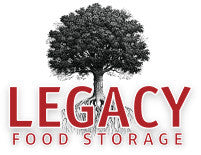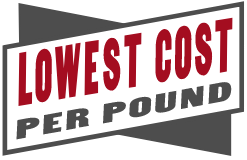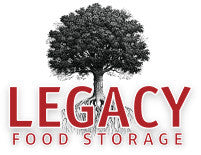How Much Food Storage Is Enough?
Did you know that the average person eats 4,000 to 5,000 calories on Thanksgiving Day alone? About 3,000 of that is just from the Thanksgiving meal! How great would it be if we could just store those extra Thanksgiving calories up for later emergencies, if we could be more like bears who binge on berries and meat for six months of the year and then live off of their fat for the other six? Emergency preparation would be so much easier. Unfortunately, we don’t have six months of the year during which to hibernate to make this kind of self-storage possible. (Maybe this isn’t such a bad thing, though, because I think I’d rather eat freeze-dried fettuccine alfredo in the winter of my life than feed off my own fat stores. I guess that’s something to add to my thankful list.)
Thanksgiving and times of plenty are a good time to be grateful for what we have and also to prepare for times when we might not have as much. A common question people have as they are gathering food storage for their emergency supply is how much food they should store to be able to feed their families. While we definitely don’t need 4,000-5,000 calories a day in an emergency, we do want to have enough food to keep our families not just alive, but healthy and thriving.
Here are a few tips when deciding how much food to store for your family.
Calculating Caloric Needs
A good place to start is to first figure out approximately how many calories your family needs in a day. If you’re not sure how to do this, you might consider calculating a rough basal metabolic rate for each person in your family. A basal metabolic rate basically tells how many calories a person needs to take in just to maintain his/her current state, to do things like pump blood through the body and keep cells performing their vital work. To calculate the bmr, the American Council on Exercise recommends using a simple formula: Adult males should multiply their weight by 12 and adult females should multiply their weight by 11. If you want something a little more sophisticated, you might want to try an online calculator like this one: http://www.mydr.com.au/tools/basal-energy-calculator.
Remember, this number is how many calories your body uses just to perform its vital functions. It does not take into consideration any physical activity. In an emergency situation, you would likely be very active and would need many more calories than your bmr. Once you have the bmr, use it as a base and then shoot for more. Add up the amount of calories your family requires in a day, then keep it in mind as you look around at your various emergency food choices.
Watch out for Serving Sizes
You can also calculate how much food to store for your family based on how many servings they would need in a certain time period. You can use this chart to figure out how many servings of food you need based on the number of people of people in your family and the number of months you want to have a supply for. For example, if you have three people in your family, and you want to start out by getting a three-month supply of food for those three people, you would need to collect 810 servings of emergency food. You can then go and select food to fill these servings.
We have one caution if you make your calculations this way: Do not trust what a company calls a serving without looking into how many calories are in that serving. “Serving” is a subjective term. Different food storage companies have varying definitions of serving sizes. Some will advertise a meal package that supposedly has three servings per day, but each serving is just 150-200 calories apiece. I don’t know about you, but if I were living on 600 calories a day–especially in an emergency situation–I don’t think I’d have much energy to do anything but think about how hungry I was. Based on the bmr, most people need somewhere between 1500 and 2500 calories a day. Six hundred calories wouldn’t even be enough for a child to thrive on. Legacy Premium’s food is always calorie-dense and sustaining. All Legacy Premium entrees have 300-400 calories apiece, and there are also plenty of side options to add in for extra calories.
Figuring out how much food you need to have stored is not as difficult as it might initially seem. Using estimated serving needs, you can collect food storage in the right amounts. Just remember to always check how many calories are in an advertised serving and keep in mind the bmr requirements you calculated for your family to know approximately how many calories to shoot for. You may not be eating like it’s Thanksgiving every day in an emergency, but with the right planning, you won’t be eating like it’s a famine either.
The post How Much Food Storage Is Enough? appeared first on Buy Emergency Food.
Tags
- All
- 25 year food
- 25 year shelf life food
- 72 hour kit
- Best food storage types
- Best long-term food storage
- Blizzard preparedness
- Budgeting
- canning
- Certified GMO-free Emergency foods
- Certified GMO-free foods
- Coffee
- Comparison of emergency food methods
- Composting tips
- Dangers of genetically modified foods
- dehydrated food
- Edible Wild Plants
- emergcy preparedness
- Emergency Cooking
- Emergency Food
- Emergency food Christmas gifts
- emergency food storage
- Emergency Food Supply
- Emergency food supply recommendations
- Emergency Planning
- Emergency Preparedness
- Emergency preparedness advice
- emergency preparednesss
- Emergency Supplies
- Emergency supplies checklist
- Emergency Survival
- emergency survival gear
- Emergency survival kit checklist
- Emergency Survival skills
- exercise
- Family emergency preparedness
- Family emergency preparedness plan
- Family Preparedness
- Food Storage
- Food storage 25 year shelf life
- Food storage amounts
- Food storage Christmas
- Food storage containers long term
- Food Storage Secrets
- Food storage serving size
- Food storage types compared
- freeze dried food
- Freeze dried food storage
- freeze dried meats
- Freeze-dried emergency food storage
- Fruit Trees
- Gardening
- Getting Started
- Gluten-free food Storage
- Gourmet emergency food
- Healthy food storage
- How much emergency food to store
- Improved emergency preparedness
- Jared Markin
- Jared Matkin
- Legacy Premium
- Lessons learned from Hurricane Sandy
- Lessons learned from natural disasters
- long-term food storage
- Long-term Food Storage Guidelines
- Long-term Food Storage tips
- Long-term water storage
- Mental Emergency Preparedness
- Mental toughness
- Money-saving tips
- Natural disaster planning
- Natural Disasters
- Perfect Christmas gifts
- Pet Emergency preparedness checklist
- Pet Emergency preparedness kit
- Pet Emergency Survival tips
- Pets and Emergency Preparedness
- Plant Foraging
- portable solar panels
- portable solar power
- portable water filters
- protein drinks
- Risk of genetic modification
- Seed saving and storage
- Seed saving guide
- Self-reliance
- Self-reliant practices
- Shelf Life
- Solar Cooking
- Solar Ovens
- Special Dietary needs
- Stranded in a car in a blizzard
- Survival food
- Survival Gear
- survival kit
- Survival kits
- Survival Ovens
- Survival Skills
- survivalist gear
- suvival kit
- Tree Pruning tips
- Tree Trimming basics
- unique ideas
- water bottle with filter
- water filter
- water filter straw
- water filters
- Water Filtration
- water pitcher with filter
- water pitchers with filters
- Water purification
- Wild Food Foraging
- Winter composting
- Winter driving
- Winter preparedness tips
- Winter storm preparedness tips
- Winter Survival








